The $4.8 Million Problem Nobody Talks About
Last year, a global apparel brand lost $4.8 million due to duplicate shipment labels. A Fortune 500 retailer discovered they were holding 31% more inventory than needed. Another company spent three weeks manually reconciling supplier invoices that should have taken three hours.
If you're reading this, you know the pain: Excel sheets that crash during critical planning cycles, visibility that ends at your warehouse door, and "real-time" systems showing yesterday's data. You've sat through vendor demos promising to revolutionize your operations, only to discover hidden costs that triple the quoted price.
This guide cuts through the marketing noise with actual implementation data, real pricing, and insights from companies that have been through the selection process.
Supply Chain Platform Snapshot
| Tool | Best For | Why It Stands Out |
|---|---|---|
| Wisor AI | Freight forwarders | 60-second quoting, AI-powered sales ops, fast ROI |
| SAP IBP | Enterprises already deep in SAP | Native ERP integration, enterprise-grade scale |
| Oracle SCM | Cloud-first manufacturers | Strong IoT + predictive maintenance, cloud-native |
| Blue Yonder | Retailers with complex forecasting needs | Deep AI models, scenario planning, digital twins |
| Kinaxis | Manufacturers breaking planning silos | Concurrent planning engine, real-time collaboration |
| Manhattan | High-volume warehousing and fulfillment | Market leader in WMS, robotics-ready |
| Coupa | Procurement-led organizations | $8T+ spend intelligence, strong supplier network |
| E2open | Global supply networks with complex partnerships | Multi-tier visibility, 500K+ trading partners |
1. Wisor AI: Speed-to-Quote Leader for Freight Forwarders

Founded: 2021 | HQ: New York, NY | Focus: AI-Powered Freight Quote Automation | Funding: $8M seed (Team8 led)
While the $500 billion freight forwarding industry still runs on spreadsheets and 3-hour manual quotes, Wisor AI built a platform that generates comprehensive door-to-door quotes in 60 seconds. Founded by CEO Raz Ronen with co-founders Eiran Bolless (ex-Mobileye analytics lead) and CTO Ido Karavany, the platform uses NLP to process email inquiries and AI to optimize pricing—letting forwarders maintain their workflows while customer-reported metrics show 25–35% more deals won through speed.
Best For: Mid-to-large freight forwarders (50+ quotes daily) seeking to win more deals through speed. Less suitable for small operations or companies needing full SCM beyond forwarding.
| Strengths | Limitations |
|---|---|
| 60-second quotes (vs 2–3 hours manual) | Freight-only, not full SCM suite |
| 25–35% more deals won (customer-reported) | Enterprise features still maturing |
| 85% reduction in sales operation time | Requires sales team buy-in for AI |
| NLP processes email inquiries automatically | Limited planning/WMS capabilities |
| 2–8 week implementation (faster than most tools) | Best for forwarding-focused ops |
Validation: Team8 (lead investor): "Creating a solution that allows them to maintain their way of working while enjoying digitization is a strong differentiator." Won Tech1's 2025 startup competition.
Pro Tip: Start with high-volume lanes for fastest ROI before full platform rollout.
2. SAP Integrated Business Planning (IBP): The Enterprise Standard
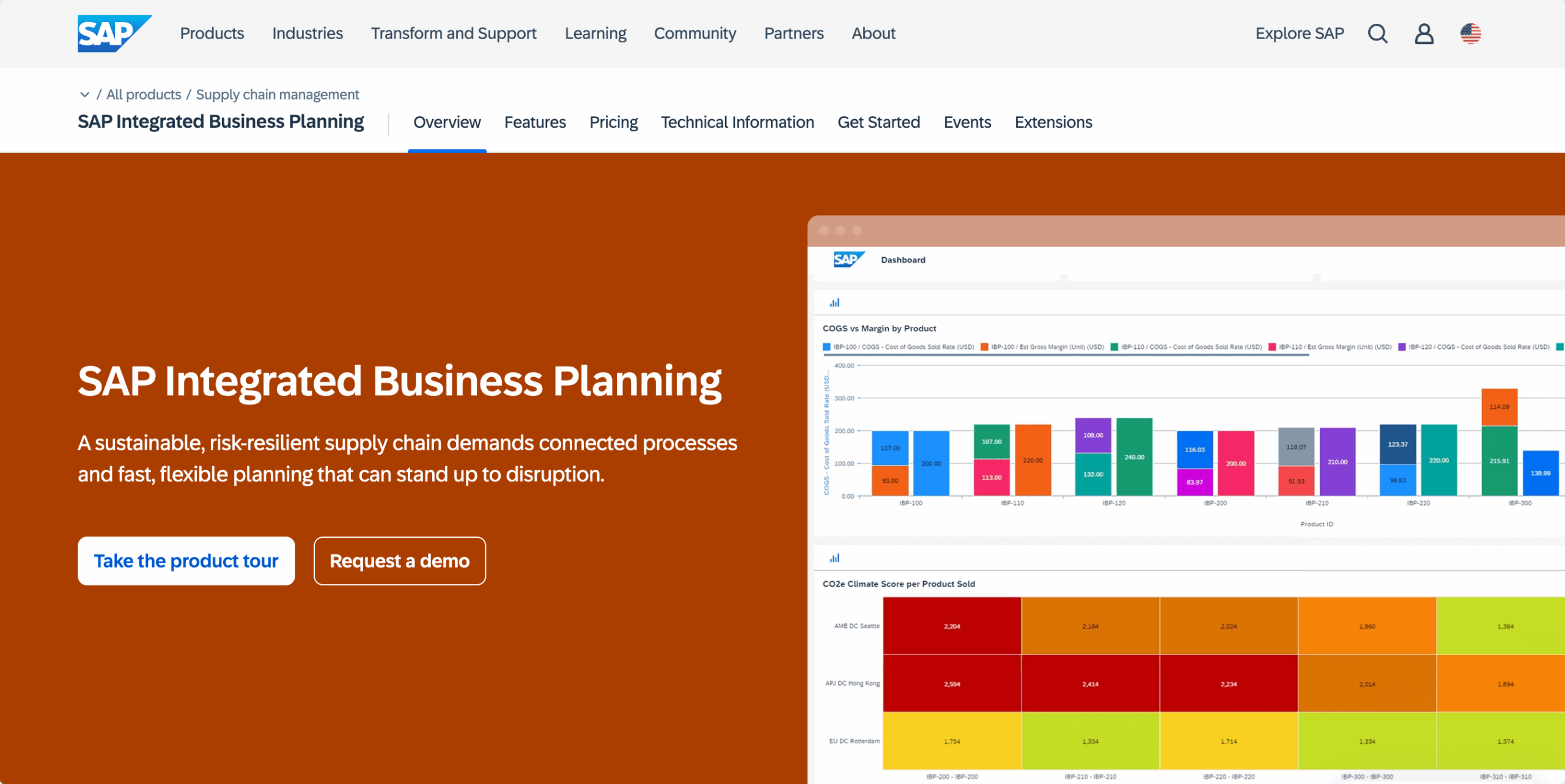
Founded: 1972 (IBP: 2014) | HQ: Walldorf, Germany | Focus: Enterprise S&OP | Revenue: €34.2B (~$37B)
SAP IBP represents German engineering applied to supply chain planning—comprehensive, complex, and costly. With 110,000 employees and clients like Kimberly-Clark, SAP built IBP as the cornerstone of their enterprise cloud strategy. The platform promises unified planning across the enterprise, but success requires significant investment beyond licenses, including $2,000/day consultants and 18-36 month implementations.
Best For: Enterprises with $1B+ revenue already in SAP ecosystem where integration trumps functionality.
| Strengths | Limitations | Pricing |
|---|---|---|
| Deep SAP ERP integration | Excel add-in performance issues | Entry: $150K/year |
| 25+ industry templates | Quarterly updates break customizations | Mid-market: $500K-1M/year |
| Unified financial planning | Planning runs take hours on large datasets | Enterprise: $2M-10M/year |
| Proven at scale (Kimberly-Clark, etc.) | Requires $2K/day consultants | Implementation: +100-200% |
| Single source of truth | 18-36 month global rollout | 30% budget overrun typical |
Reality: German engineering meets supply chain—comprehensive but complex. If you're already married to SAP, this is your only real choice.
3. Oracle Cloud SCM: The Cloud Transformation Leader
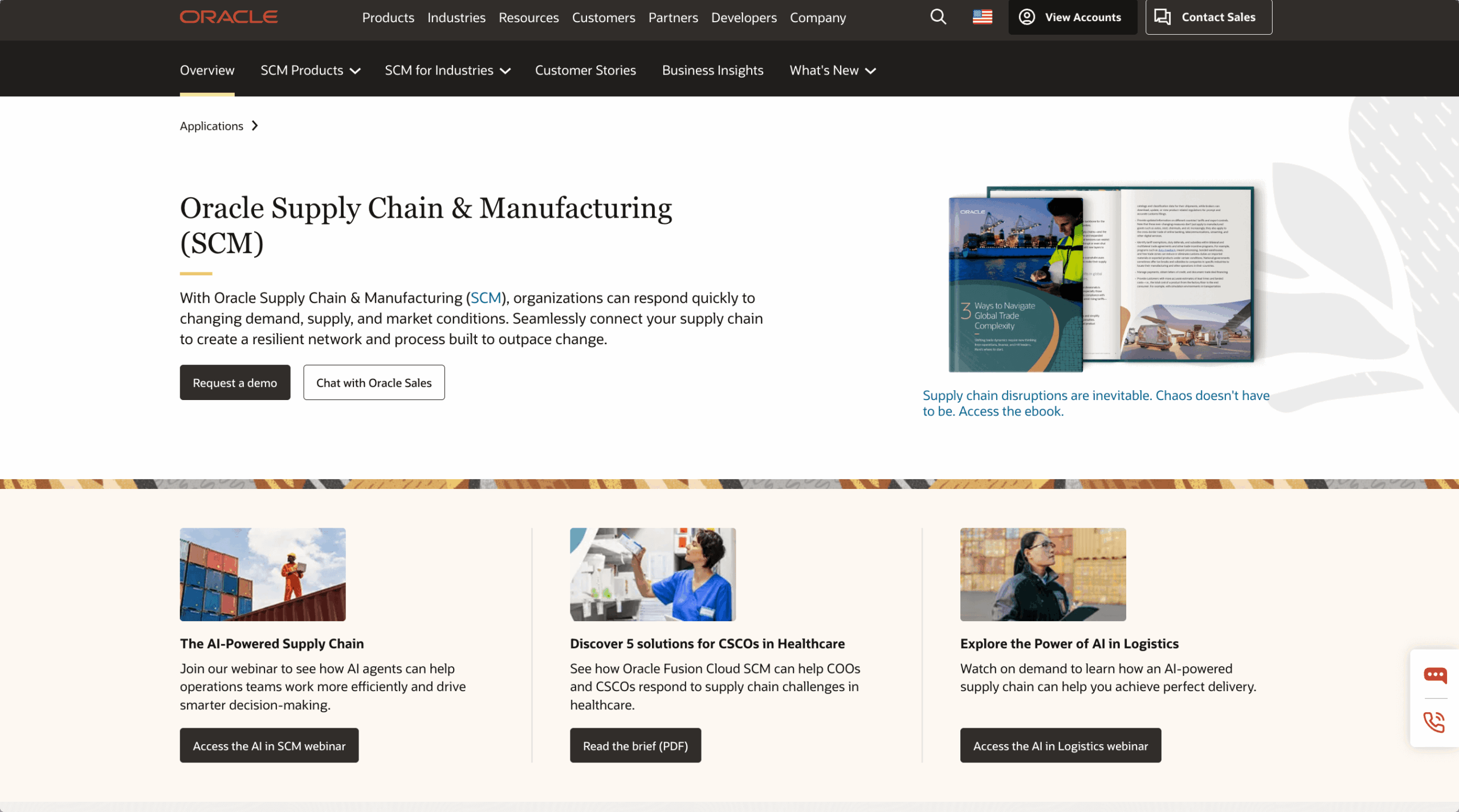
Founded: 1977 (Cloud: 2016) | HQ: Austin, Texas | Focus: Cloud-Native Platform | Revenue: $50B
Oracle's 164,000 employees completely rebuilt their SCM suite for the cloud era under CEO Safra Catz. The platform delivers advanced predictive maintenance and IoT integration capabilities. As a 10-time consecutive Gartner WMS Leader (2025), Oracle delivers quarterly updates without downtime—but watch for data volume pricing that can increase costs 30% in year two.
Best For: Cloud-first organizations with complex manufacturing and IoT requirements.
| Strengths | Limitations | Pricing |
|---|---|---|
| Quarterly feature updates without downtime | Data volume pricing spirals year 2 | Starts: $350/user/month |
| Advanced IoT and predictive maintenance | Module creep inevitable | Mid: $75K-500K/year |
| 10x consecutive Gartner WMS Leader | $200K average integration cost | Enterprise: $1M+/year |
| True cloud-native architecture | Limited Oracle partner ecosystem | Hidden: +30% year 2 |
| Proven enterprise scale | 2x longer for migrations vs greenfield | 4-12 month implementation |
Reality: Oracle rebuilt everything for the cloud. Innovation is real, but watch those data costs balloon.
4. Blue Yonder (Luminate): The AI Pioneer
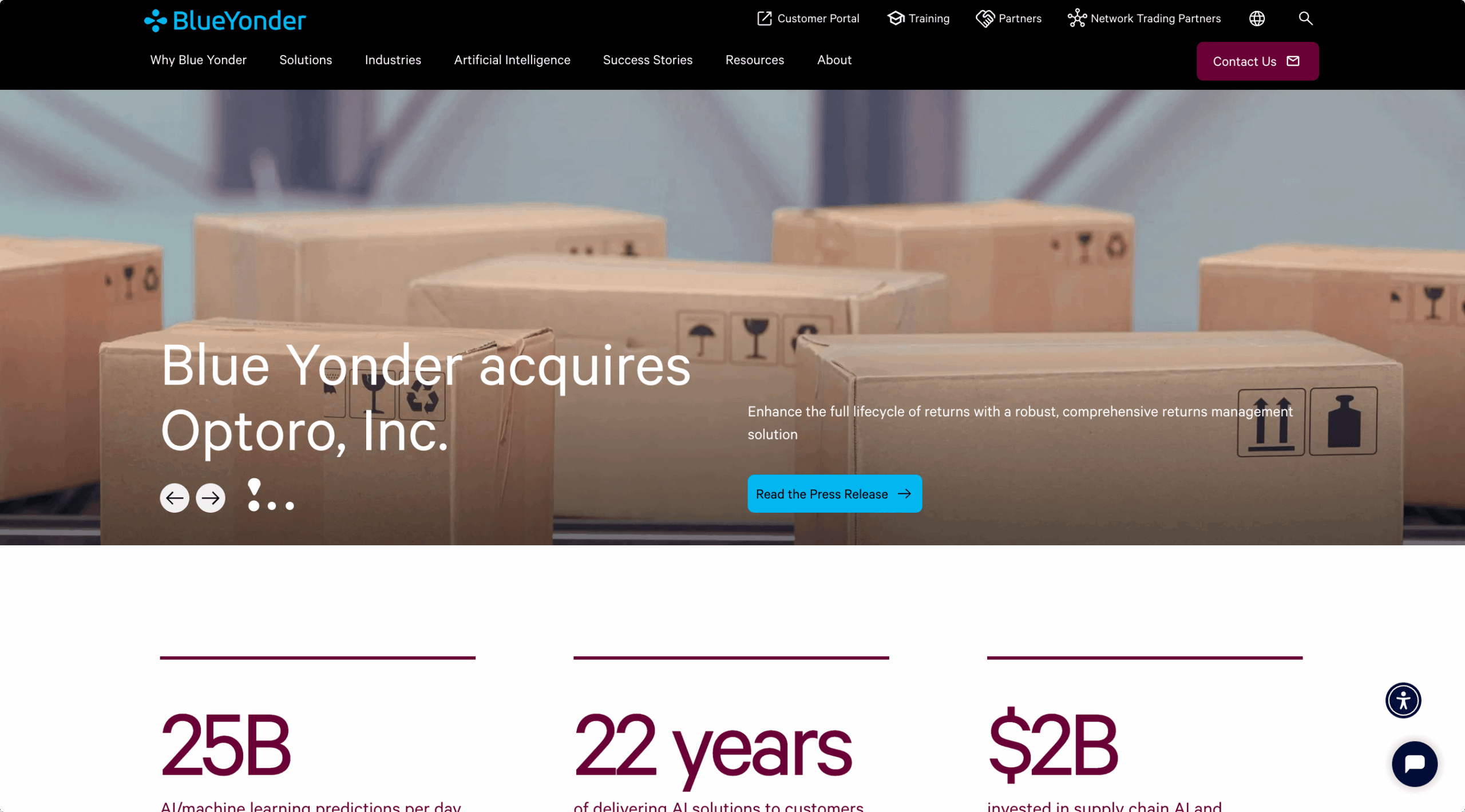
Founded: 1985 | HQ: Scottsdale, Arizona | Focus: AI-Driven Planning | Revenue: $1.3B
Blue Yonder (formerly JDA) has 35 years of supply chain data feeding their ML models—an unreplicable moat. With 6,000 employees serving 3,000 brands including Heineken and Panasonic, their Luminate platform analyzes 200+ demand variables. CEO Duncan Angove pushes "autonomous supply chains," but users report 6+ months to proficiency and "black box" AI that's hard to explain to stakeholders.
Best For: Retailers $500M+ with volatile demand and data science teams to interpret AI recommendations.
| Strengths | Limitations | Pricing |
|---|---|---|
| 35 years ML training data | 6+ months to user proficiency | Base: $100K minimum |
| 200+ demand variables analyzed | Black box AI recommendations | Typical: $600K-3M total |
| Powers 7/10 largest retailers | Hours for large optimizations | Transaction-based spiral |
| Digital twin scenario testing | 60% features unused after year 1 | 3-9 month implementation |
| Heineken, Panasonic clients | Steep learning curve | High data scientist need |
Reality: Most mature AI in market, but complexity means most companies use 40% of capabilities.
5. Kinaxis Maestro: Concurrent Planning Revolutionary
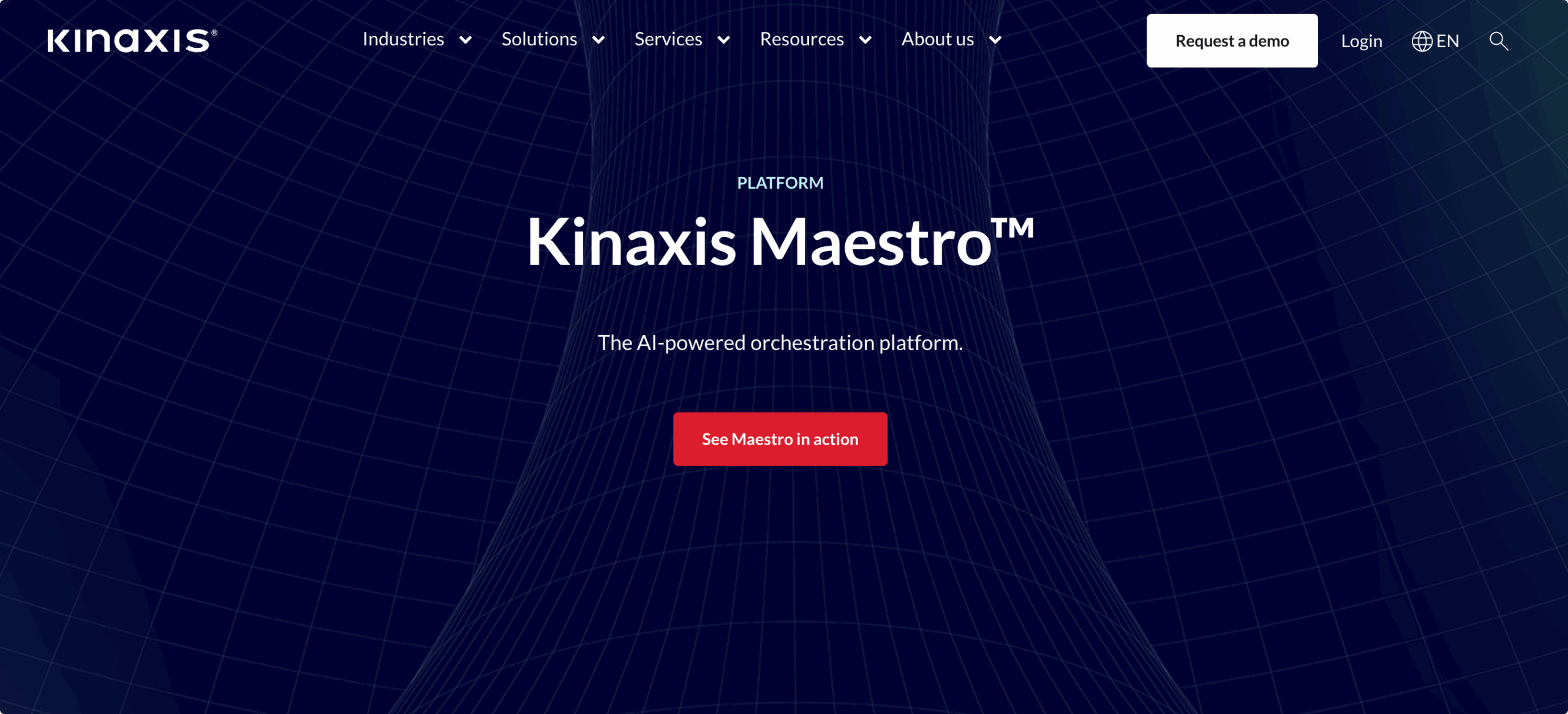
Founded: 1984 | HQ: Ottawa, Canada | Focus: Unified Planning | Revenue: $515M (TTM)
Kinaxis rejected traditional planning silos, building everything on a single concurrent platform. CEO John Sicard leads 1,800 employees who've created something unique: when any planner makes a change, everyone sees the impact instantly. Their Cognitive Network Graph enables unlimited what-if scenarios in seconds, but success requires completely rethinking how you plan—a paradigm shift many aren't ready for.
Best For: Complex manufacturers (aerospace, pharma) ready to abandon traditional planning cycles.
| Strengths | Limitations | Pricing |
|---|---|---|
| True concurrent planning | Requires complete process redesign | Base: $80K+ |
| Instant what-if scenarios | Power user dependent | Typical: $400K-2M |
| No latency between modules | Limited execution features | RapidStart: $200-400K |
| Self-healing plans | Paradigm shift needed | 12 weeks typical with RapidStart |
| Single data model | Weak in WMS/execution | High training investment |
Reality: Revolutionary approach that works—if you're willing to rethink everything about planning.
6. Manhattan Associates: The Warehouse Powerhouse
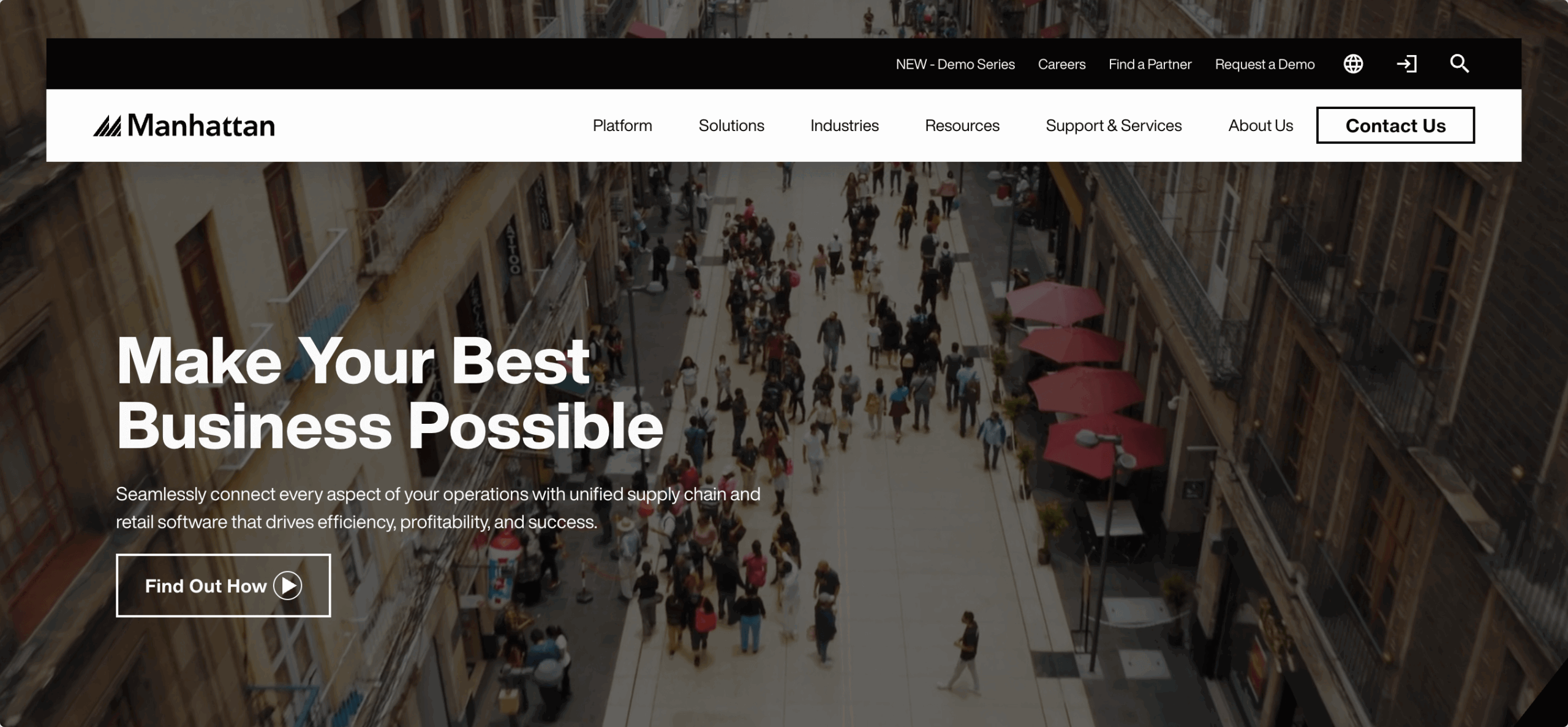
Founded: 1990 | HQ: Atlanta, Georgia | Focus: WMS Excellence | Revenue: $1.06B (TTM)
CEO Eddie Capel's 4,300 employees are obsessed with warehouse excellence. As 17-time Gartner WMS Leaders, Manhattan runs 1,200+ DCs globally for clients like Giant Eagle, Crocs, and WSI. Their cloud-native Manhattan Active WM delivers "no upgrades ever" with 40+ robotics integrations and gamification that drives 30% throughput increases. But their laser focus means limited capabilities beyond the warehouse walls.
Best For: 3PLs, omnichannel retailers with 100K+ SKUs where warehouse IS the business.
| Strengths | Limitations | Pricing |
|---|---|---|
| 17x Gartner WMS Leader | Warehouse-only focus | SCALE: $75-200K/year |
| 1,200+ DCs globally | Weak beyond four walls | Active: $200-500K/year |
| 40+ robotics integrations | Complex pricing structure | Plus: $0.10-0.50/order |
| 30% throughput increase typical | Requires dedicated DC IT team | 6-12 months per DC |
| No upgrades ever (cloud-native) | Operations shutdown for go-live | Giant Eagle, Crocs clients |
Reality: If your business lives in the warehouse, Manhattan is unmatched. Just don't expect supply chain planning.
7. Coupa: The Spend Management Bridge
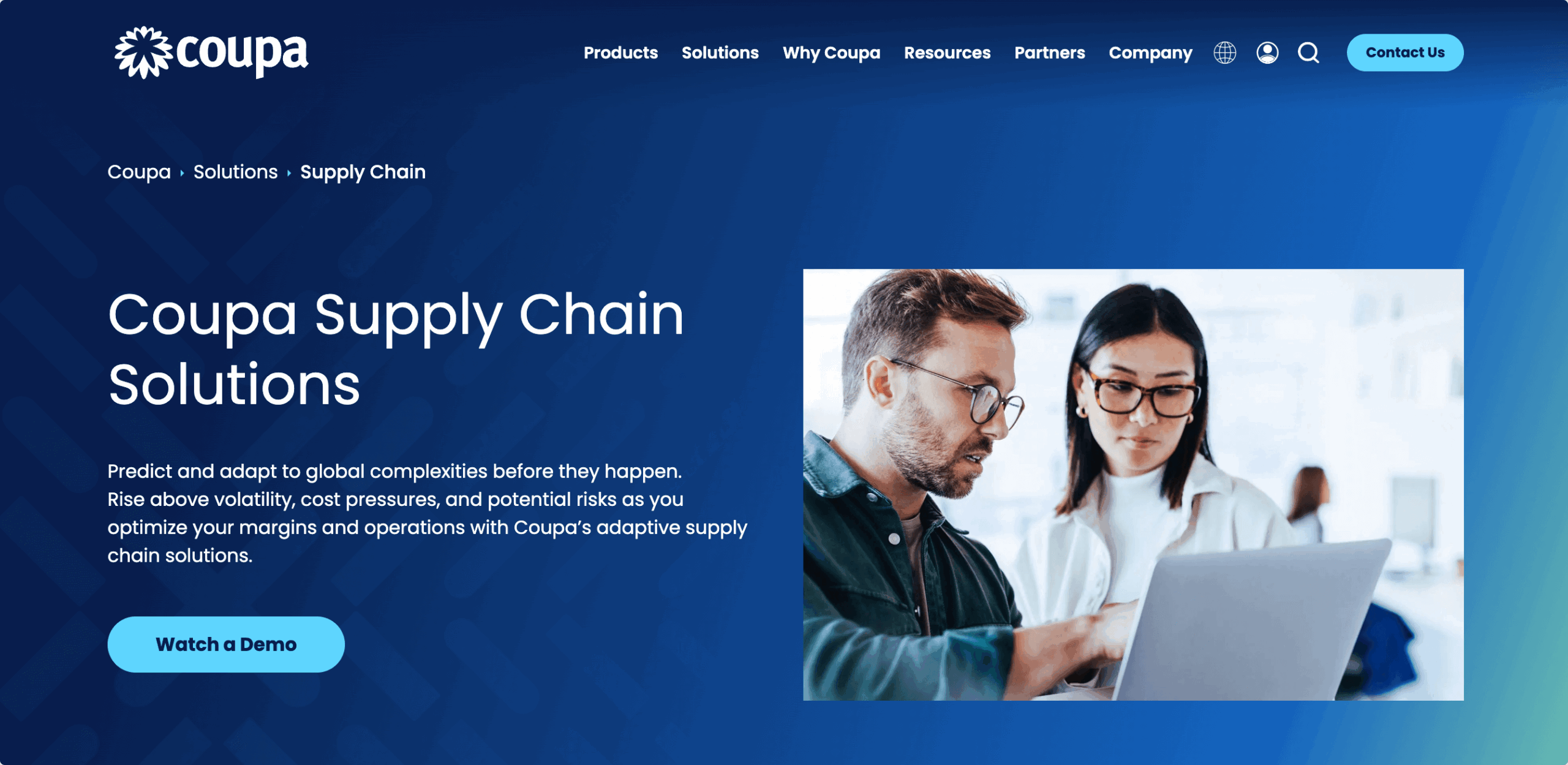
Founded: 2006 | HQ: San Mateo, California | Focus: Business Spend Management | Private under Thoma Bravo
CEO Leagh Turner's 3,000+ employees approach supply chain from the money side. Their platform connects 10M buyers/suppliers managing $8 trillion in spend data. After acquiring LLamasoft, Coupa bridges procurement and supply chain planning with 80%+ user adoption through consumer-grade UX. But they lack WMS capabilities and planning features are still developing.
Best For: Companies prioritizing spend optimization with large supplier networks.
| Strengths | Limitations | Pricing |
|---|---|---|
| $8T spend intelligence network | No WMS capabilities | Entry: $60K/year |
| 10M+ buyers/suppliers connected | Planning features developing | Typical: $300K-1M total |
| 80%+ user adoption rate | Limited execution features | Based on spend volume |
| Consumer-grade UX | Value needs supplier participation | 3-6 month core |
| LLamasoft integration | Not for operations-first companies | ROI tied to network effect |
Reality: Approaches supply chain from the money side. Great for procurement-led transformations.
8. E2open: The Network Orchestrator
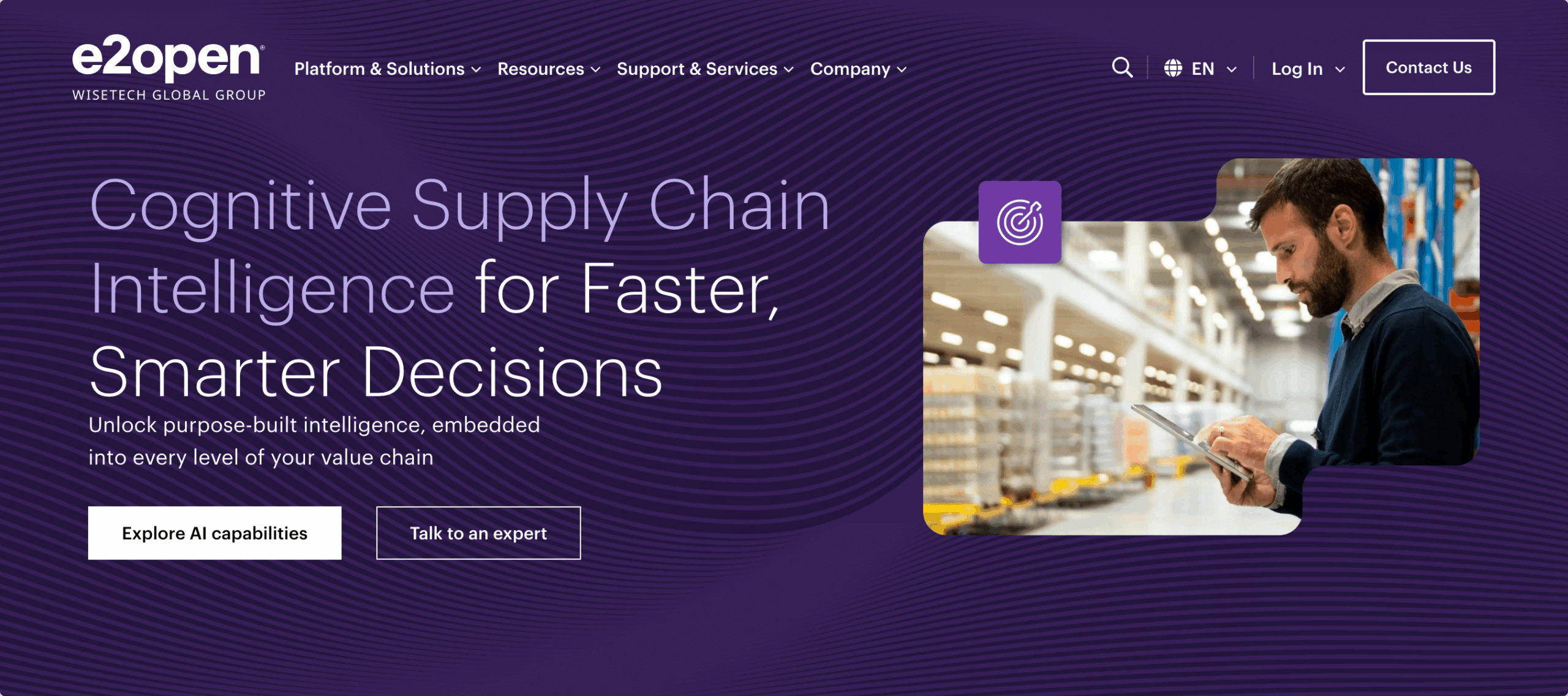
Founded: 2000 | HQ: Austin, Texas | Focus: Multi-Enterprise Networks | Acquired by WiseTech
Started as a joint venture between IBM, Hitachi, and Toshiba, E2open now connects 500,000+ trading partners processing 18 billion transactions annually. CEO Andrew Appel built this network through acquisitions (ICON-SCM, Terra Technology, INTTRA), but integration remains incomplete. WiseTech completed the $2.1B acquisition (enterprise value) in 2025, adding uncertainty to the platform's future direction though its multi-tier visibility and 195-country compliance remain unmatched.
Best For: Global manufacturers with complex partner networks needing multi-tier visibility.
| Strengths | Limitations | Pricing |
|---|---|---|
| 500K+ trading partners | Acquisition patchwork not integrated | Entry: $50K minimum |
| 18B transactions annually | Performance issues at scale | Typical: $250K-1.5M |
| 195 country compliance | WiseTech integration uncertainty | Transaction fees apply |
| True Tier 2/3 visibility | Ongoing partner onboarding needed | 4-10 month implementation |
| Channel orchestration leader | Future roadmap unclear post-acquisition | Network value dependent |
Reality: Massive network is the moat. WiseTech acquisition completed at $2.1B EV—expect changes.
Quick Decision Matrix
Choosing the right supply chain management tool depends on where your current bottlenecks are and how your teams operate. Use this table to match your top priorities with platforms built to solve them.
| If Your Priority Is... | Top Picks | Why They Stand Out |
|---|---|---|
| Freight forwarding speed | Wisor AI, Oracle SCM | Wisor enables 60-second door-to-door quoting. Oracle adds freight capabilities at scale with broader SCM coverage. |
| Fast time-to-value | Wisor AI, Nightfall | Wisor offers full quoting and sales ops automation within weeks. Nightfall is ideal for instant SaaS data protection. |
| SAP ecosystem integration | SAP IBP, E2open | SAP offers native integration with ERP and finance. E2open complements SAP with supplier visibility and coordination. |
| AI-powered planning | Blue Yonder, Wisor AI | Blue Yonder leads in demand sensing and AI-driven forecasting. Wisor applies AI to quoting, pricing, and routing logic. |
| Breaking planning silos | Kinaxis, Coupa | Kinaxis connects all planners on a unified real-time model. Coupa integrates planning with procurement strategy. |
| Cloud-first modernization | Oracle SCM, Wisor AI | Oracle rebuilt its suite for the cloud from the ground up. Wisor delivers a focused, agile SaaS experience built for speed. |
| Warehouse optimization | Manhattan, Blue Yonder | Manhattan dominates core WMS capabilities. Blue Yonder combines warehouse planning with AI-powered execution. |
| Spend and supplier control | Coupa, E2open | Coupa brings transparency to procurement and supplier networks. E2open adds visibility across global trading partners. |
| Quote-to-cash automation | Wisor AI, SAP IBP | Wisor simplifies and speeds up the full quoting process. SAP handles complex quote-to-cash across enterprise systems. |
| Multi-tier visibility | E2open, Oracle SCM | E2open specializes in partner orchestration and tier 2/3 visibility. Oracle enables broad supply chain data integration. |
Note: No tool does everything. The best fit depends on your workflows, data maturity, and how fast your teams can adapt.
How to Successfully Roll Out a Supply Chain Management Tool
Modern supply chain platforms are faster to deploy than ever. But faster tech doesn’t mean guaranteed success. What separates teams that see results from those that stall is how they handle setup, rollout, and iteration.
Before You Start (Weeks -4 to 0)
- Test your data with a real workflow, not just exports
- Map how decisions are made day to day — not just what the org chart says
- Involve actual users early and often
- Set one or two success metrics that matter at the team level
Setup and Selection (Weeks 1 to 4)
- Always ask for hands-on access with real data
- Start small: one process, one team, one region
- Choose tools that fit how your team already works
- If adoption doesn’t start within the first few weeks, fix the friction fast
Go Live and Ramp Up (Weeks 5 to 12)
- Launch with a clear use case and visible wins
- Keep existing systems available, but set a hard date to phase them out
- Track usage weekly — not just logins, but real workflow impact
- Share wins inside the team to build momentum
Continuous Improvement (Month 3 and beyond)
- Plan for feature expansion like product launches, with owners and goals
- Schedule regular reviews to eliminate workarounds and friction points
- Refresh training quarterly, especially as new capabilities roll out
- Make iteration part of the budget, not an afterthought
Good implementation today is less about big launches and more about fast learning loops. Momentum builds through clarity, focus, and follow-through.
Critical Success Factors
Before you compare features, make sure these foundations are in place. In most implementations, they drive outcomes more than the software itself. The rules of thumb below reflect common patterns in large SCM and ERP rollouts. Exact numbers vary by company size and complexity.
| Factor | Why it matters | Practical rule of thumb |
|---|---|---|
| Data quality | Top cause of delays and rework | Start profiling and cleanup 3 to 6 months before kickoff. Expect data tasks to take twice as long. |
| Change management | Biggest driver of user adoption | Earmark 20% to 30% of total budget for training, pilots, and communications. |
| Executive sponsorship | Unblocks decisions and resources | Set a weekly steering meeting with a VP or C level. Track 3 key success metrics weekly. |
| Super users | Sustains new behaviors after go live | Assign 1 super user per 8 to 12 users. Provide extra training and hands-on support time. |
| Integration planning | Hidden risk multiplier | Map every system and data flow pre-contract. Treat each integration as its own scoped project. |
Note: These are realistic benchmarks, not guarantees. Adapt based on scope, complexity, and team readiness.
Expert Tip: Don’t Launch Without a Single Source of Truth for Product Data
The #1 bottleneck in most SCM rollouts? Conflicting product data.
Before go-live, make sure there's one clean, accessible source of truth for SKUs, units of measure, lead times, suppliers, and cost tiers — and that every connected system agrees.
Common issues that wreck timelines:
- One team uses pallet-level UOM, another uses units
- Duplicate SKUs with different naming conventions
- Supplier info missing delivery windows or MOQ
- Systems calculating margin off outdated costs
You don’t need it to be perfect — just consistent.
Fixing this after implementation often takes longer than the setup itself.
The Bottom Line
There's no perfect SCM platform. The winners aren't companies that bought the best technology—they're companies that:
- Started with clean data (not hoped it would fix itself)
- Invested in change management (not just training)
- Chose platforms matching their maturity (not their aspirations)
- Committed to multi-year transformations (not quick fixes)
- Measured success by adoption (not features deployed)
Technology amplifies what you already do—good or bad. Choose accordingly.
Methodology: Analysis based on publicly available information, vendor documentation, implementation data, and industry reports through August 2025. Pricing and features change frequently—verify current details with vendors.